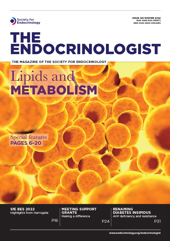An enormous amount of research effort is currently being directed at understanding the factors that regulate activation of brown adipose tissue (BAT), and the conversion of beige adipocytes from their white to their brown phenotype: the browning of white adipose tissue (WAT).1 The principal aim of this work is to find drugs or other interventions that can switch on BAT or cause browning of WAT in humans, to stimulate energy expenditure and burn off lipids, thereby reducing the level of obesity. There is, however, some worrying evidence that the whole approach of switching on BAT may be flawed.
An argument supporting the research effort is that cross-sectional studies in humans show that individuals with more BAT have less WAT.2 However, the direction of causality in that relationship remains unclear. It could be that high levels of BAT do indeed stimulate expenditure and burn off WAT. But an alternative, and equally tenable, hypothesis is that the insulation provided by large amounts of WAT reduces the thermoregulatory requirement to activate BAT.3
BAT AND COLD EXPOSURE
BAT is responsive to cold exposure, and there is a seasonal cycle of BAT activation in temperate regions. If activated BAT leads to reduced WAT, then one would predict that there would be an association between the average annual ambient temperature of a location and the prevalence of obesity there. Six years ago, we merged data on the age-normalised prevalence of obesity across the 3000+ counties in the mainland USA and data on the ambient temperature in each county, and found that there is no association between obesity prevalence and temperature.4
'Humans have a unique capacity to buffer environmental impacts on expenditure, by modifying their environment and rapidly changing their external insulation (clothing).'
Surprisingly, however, there was an effect of temperature on the prevalence of type 2 diabetes. This was a big effect, explaining more than 25% of the variation in the prevalence of the condition, more than the variance explained by all the genetic targets for type 2 diabetes combined!
WHY ELEVATED BAT MAY NOT LOWER OBESITY
Does this mean switching on BAT to treat obesity won’t work? Possibly, but it’s not clear cut. There are several reasons why elevated BAT activity might not translate to lowered obesity rates. The first is that increased energy demands from activated BAT may stimulate food intake. This seems to be a major reason why increasing physical activity energy expenditure (AEE) is not very effective for weight loss. A second problem is that activating BAT might be offset by changes in other components of the energy budget, like AEE. These effects would compromise the utilisation of activation of BAT as a strategy to combat obesity.
Another possibility, however, is that humans have a unique capacity to buffer environmental impacts on expenditure, by modifying their environment and rapidly changing their external insulation (clothing). These are options that are unavailable to most other mammals.
AMBIENT TEMPERATURE AND FREE-LIVING ENERGY EXPENDITURE
The impact of ambient temperature changes on free-living energy expenditure was, until recently, unknown. This is because the gold standard, doubly labelled water (DLW) method for measuring such changes is expensive, and has generally been applied to small samples. Even when large samples have been measured, these have come from geographically restricted areas.
The pooling of DLW data in a large international database sponsored by the International Atomic Energy Agency5 has opened up the opportunity to explore the role of ambient temperature effects on total energy expenditure (TEE). Such an analysis based on more than 3000 measures of TEE across the USA has just been published.6
These data show that, although the ambient temperature varied between –10°C and +30°C, there was no relationship at all between the TEE and temperature. Moreover, when the data were split down into basal and activity expenditure, there were no trends in these either. This suggests any cold-induced increases in basal expenditure due to activating BAT were not being offset by lowered AEE to keep the total constant. Much more likely was that the expenditure was not being stimulated at all by the cold, due to the buffering effects.
Supporting this idea, a review of the temperatures inside buildings showed that these are sustained over a much narrower range, between 18°C and 25°C, independent of the temperature outside. Humans buffer their exposure to cold by not going outside very much, wearing clothing that mitigates any effects when outside, and keeping the temperatures inside their homes and workspaces at a temperature that does not necessitate large amounts of themoregulatory heat production. Consequently, TEE is independent of ambient temperature, and that is probably the main reason why we didn’t previously find any link between ambient temperature and the prevalence of obesity.
WHAT DOES THIS MEAN?
This work has several implications. The first is that, because there is no relationship between TEE and ambient temperature, the absence of a relationship between ambient temperature and obesity prevalence cannot be used as an argument that switching on BAT will not work as an anti-obesity strategy.
Secondly, humans routinely occupied building spaces at temperatures between 18°C and 25°C. That is somewhat lower than the thermoneutral zone for lightly clothed humans of 23°C to 30°C.7 Humans live at these sub-thermoneutral temperatures, probably because this is the optimal temperature to dissipate their heat production generated from a combination of basal and activity expenditure. In contrast, thermoneutral temperatures are optimal only to dissipate basal expenditure. Because humans do not routinely exist at basal metabolism and live at thermoneutral, then the argument that we should keep mice at 30°C (mouse thermoneutral),8 and that this will provide maximal translational efficiency to humans, makes no sense. Rather, keeping mice a few degrees below their thermoneutral temperature would seem a much better option to maximise translational relevance of mouse models.9
A WIDER PERSPECTIVE
Finally, there are some wider ramifications of this work that extend far beyond the realms of endocrinology and physiology. By engineering their environments, humans are able to stay in a comfortable temperature, despite the temperature outside fluctuating enormously. The measures of TEE show that this is a phenomenally successful strategy. Whether this pattern is also evident in populations that do not have access to air-conditioning and heating is interesting but, at the moment, we do not have a large enough sample of TEE data from such communities to test the idea.
Manipulating our environment to avoid having to thermoregulate comes at a huge energy cost. The energy demands for heating and cooling buildings to keep them in our comfort zone occupies between 18% and 73% of total building energy use.10 In 2010, the building sector accounted for 32% of global energy demand and 30% of energy-related CO2 emissions.
Engineers are already well aware of these issues, and improving the efficiency of building temperature regulation is a key goal. However, this debate has largely proceeded on the assumption that we have to keep buildings at their current temperatures and then focus on how to achieve that by adjusting building insulation and efficiency. Comparatively little effort has been directed towards understanding what the consequences might be of shifting the burden of thermoregulation away from buildings and back onto individuals.
This is not a simple calculation. Increasing individual energy demands could require greater food intake, and hence increases in the global climate burden associated with food supply, and may exacerbate concerns over future food security, especially in a warming climate. Moreover, keeping people warm in winter may reduce cold temperature-related mortality. Hence, the balance between heating/cooling our environment to keep TEE stable or pushing those costs onto the individual has diverse and complex consequences.
However, what is clear at the moment is that we are literally destroying the planet so we can stay comfortable in our living spaces. Relatively small changes in the temperatures at which we regulate our homes can have big impacts on building energy use, with minimal impacts on comfort, because they can be ameliorated by using our second unique capacity with respect to themoregulation: that is, the ability to rapidly adjust our external insulation (clothing).
And, if we decide not to make such clothing adjustments, that may – in the end – be the easiest strategy of all to activate BAT and treat obesity. Impacting two of the biggest current issues on the planet (obesity and climate change) may be as simple as turning down the thermostat dial in your living room!
John R Speakman
Shenzhen Institutes of Advanced Technology, Chinese Academy of Sciences, Shenzhen, China, and School of Biological and Environmental Sciences, University of Aberdeen, Aberdeen
REFERENCES
1. Li L et al. 2019 Molecular Aspects of Medicine 68 60–73.
2. Van Marken Lichtenbelt W et al. 2009 New England Journal of Medicine 360 1500–1508.
3. Speakman JR 2018 Thermoregulation: from Basic Neuroscience to Clinical Neurology 156 431–443.
4. Speakman JR & Heidari-Bakavoli S 2016 Scientific Reports 6 e30409.
5. Speakman JR et al. 2019 Annals of Nutrition & Metabolism 75 114–118.
6. Zhang XY et al. 2022 iScience doi: 10.1016/j.isci.2022.104682.
7. Brytcha RJ et al. 2019 Journal of Clinical Endocrinology & Metabolism 104 4865–4878.
8. Fischer AW et al. 2018 Molecular Metabolism 7 161–170.
9. Keijer J et al. 2019 Molecular Metabolism 25 168–176.
10. Urge-Vorsatz D et al. 2015 Renewable & Sustainable Energy Reviews 41 85–98.






